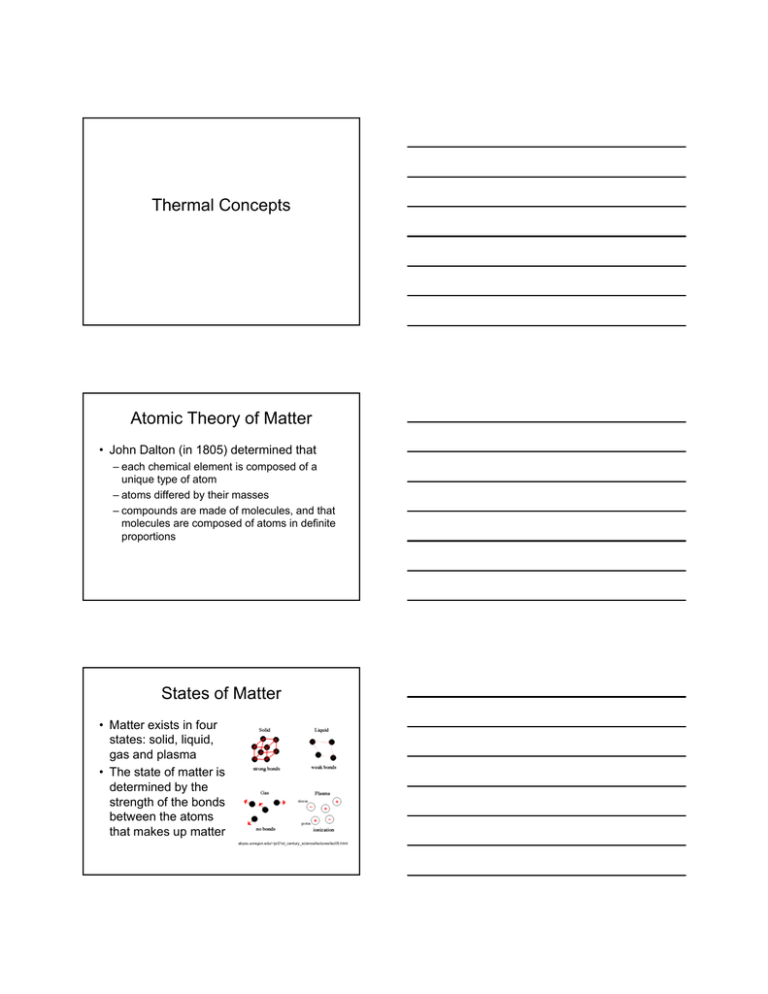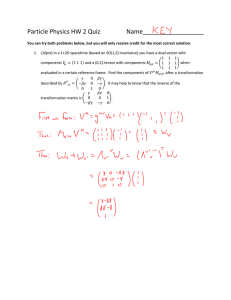Thermal Concepts Atomic Theory of Matter
advertisement

Thermal Concepts Atomic Theory of Matter • John Dalton (in 1805) determined that – each chemical element is composed of a unique type of atom – atoms differed by their masses – compounds are made of molecules, and that molecules are composed of atoms in definite proportions States of Matter • Matter exists in four states: solid, liquid, gas and plasma • The state of matter is determined by the strength of the bonds between the atoms that makes up matter abyss.uoregon.edu/~js/21st_century_science/lectures/lec05.html Temperature • In every day life, temperature is a measure of how hot or cold something is • Temperature is explained in atomic theory as the motion of the atoms – Temperature is proportional to the random kinetic energy of the molecules Temperature Scale • A temperature scale is created by setting arbitrary values to two readily reproducible temperatures – Daniel Gabriel Fahrenheit (1724) • freezing point water = 32, boiling point water = 212 – Anders Celsius (1747) • freezing point water = 100, boiling point water = 0 • (points were switched a year later) Absolute Temperature • William Thomson, 1st Baron Kelvin (Irish physicist and engineer), stated in a paper in 1848 that there needed to be a scale where the coldest temperature was zero – Kelvin (or absolute temperate) scale • Starts at 0, and has increments equal to Celsius degrees T / K T / C 273 Heat • When two objects at different temperatures are put in contact, heat flows spontaneously from the hotter one to the colder one • Given enough time the temperature of the objects will be come the same (thermal equilibrium) and there will be no heat flow between them • Heat is the transfer of energy from one body to another as a result of a difference in temperature • Heat only moves in one direction – From a hotter body to a colder one Internal Energy • The particles in a substance are in constant motion (kinetic energy) • There are also forces between the particles (potential energy) • The total random kinetic energy of the particles of a substance plus the total inter-particle potential energy of the particles • If heat flows into an object, work is done on the particles changing the internal energy • Temperature, in kelvins, is directly proportional to the average kinetic energy of the particles Phase Changes • During a phase change, the energy added or removed changes the potential energy of the particles • Supplied heat does work on the particles separating them (breaking the bonds) • The temperature does not change during a phase change Heat Added Heat Removed Melting (solid to liquid) Freezing (liquid to solid) Vaporization (liquid to gas) Condensation (gas to liquid) Sublimation (solid to gas) Deposition (gas to solid) Specific Heat Capacity • The energy required to increase the temperature of a unit mass of a body by one kelvin • Symbol: c • The amount of heat necessary to increase the temperature of a mass, m, by ∆T is given by Q mcT Note: ∆T is always positive since heat always flows from hot to cold Example 1 • If 200cm3 of tea at 95ºC is poured into a 150g glass cup initially at 25ºC, what will be the final temperature, T, of the mixture when equilibrium is reached, assuming no heat flows to the surroundings. • cwater = 4186 J kg-1 ºC-1 • cglass = 840 J kg-1 ºC-1 Qlost by tea Qgained by cup mtea ctea Ttea mcup ccup Tcup mtea V (1.0 10 6 kgm 3 )(200 10 6 m 3 ) 0.20 kg (0.20kg )(4186Jkg 1 C 1 )(95C T ) (0.150kg)(840Jkg 1 C 1 )(T 25C) T 86 C Example 2 • A 0.150kg sample of an unknown metal is heated to 540ºC. It is then quickly place in 400g of water at 10ºC, which is contained in a 200g aluminum calorimeter cup. The final temperature of the mixture is 30.5ºC. Calculate the specific heat of the unknown metal. • caluminum = 900 Jkg-1ºC-1 Qlost by Qgained by Qgained by sample water calorimeter cup ms cs Ts mw cw Tw mcalccal Tcal cs cs mw cw Tw mcal ccal Tcal ms Ts (0.4 kg )(4186 Jkg 1 C 1 )(30.5C 10C) (0.2 kg)(900 Jkg 1 C 1 )(30.5C 10C) (0.150 kg)(540C 30.5C) cs 500 Jkg 1 C 1 Specific Latent Heat • The amount of energy required to change the phase of a unit mass at constant temperature • Symbol: L • The energy required to change the phase of a mass m is given by Q mL • The specific latent heat of vaporization (vaporizing or condensing), Lv, is always greater than the specific latent heat of fusion (melting or freezing), Lf – The increase in separation of the particles is much larger when going from a liquid to a gas than from a solid to a liquid – Therefore, more work is required to separate the particles – So, more energy is needed Example • You add ice cubes to cool 355 ml of hot coffee (85 °C) to cool it down to 55 °C. What mass of ice cubes at -18.5 °C should be added? – Assume there is no thermal energy lost to the surroundings or to the coffee cup. – cwater = 4186 Jkg-1°C-1 – cice = 2050 Jkg-1°C-1 – Lf water = 333 kJkg-1 Qlost by coffee Qgained by ice mc cc Tc mi ci Ti mi L f mwcw Tw Coffee is essentially water: mc = 0.355 kg The mass of solid ice is the same as the amount of liquid(melted) ice mi mc cc Tc ci Ti L f cw Tw mi 0.074 kg






